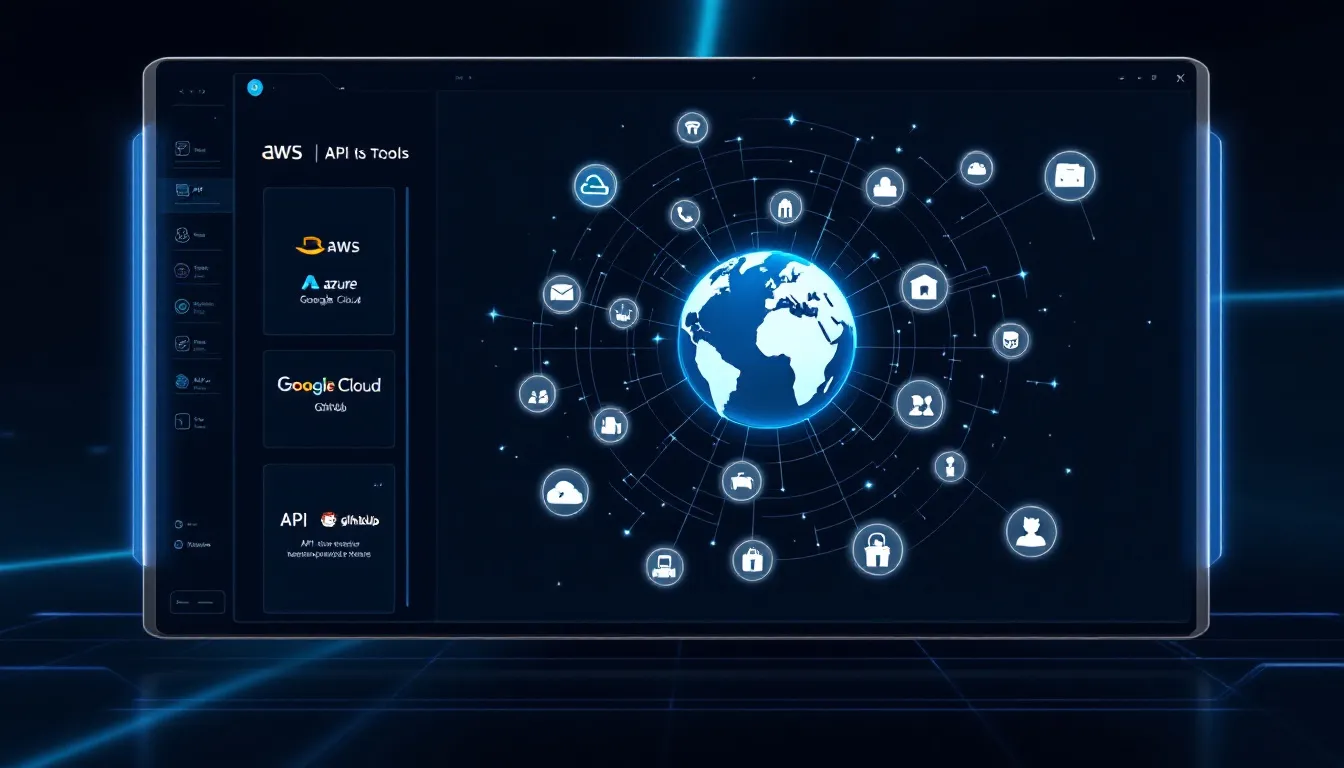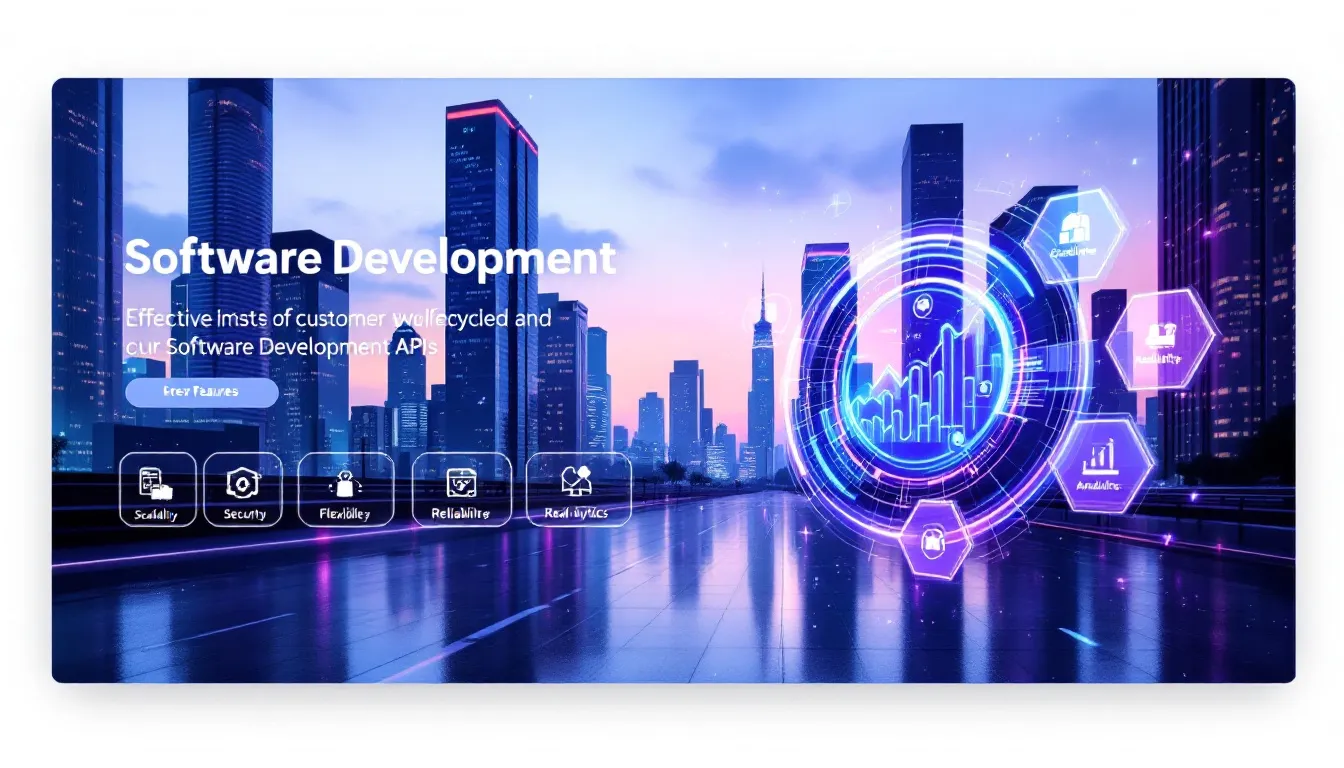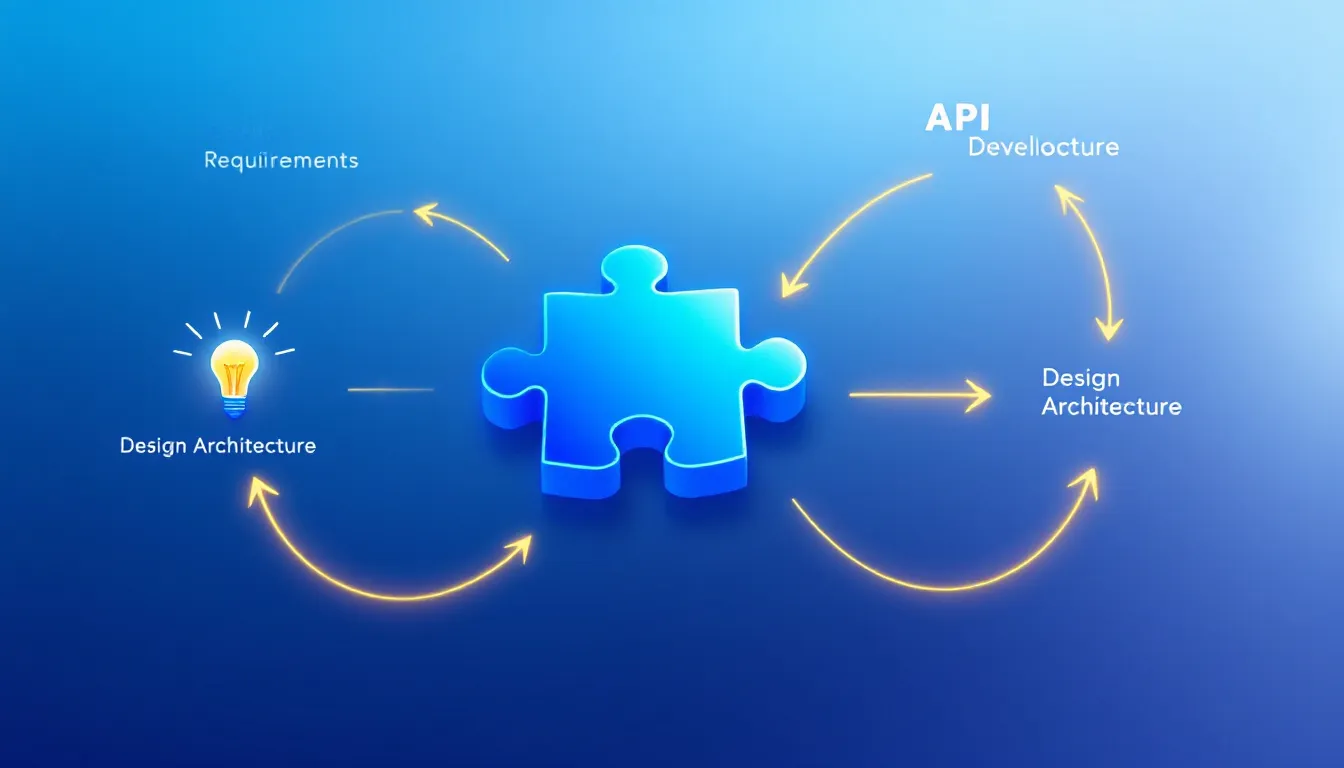Best Practices for Customer Software Development APIs: A 2024 Guide
Customer software development APIs are pivotal for integrating diverse applications and enhancing user experiences. They streamline communication between software systems, boosting efficiency and scalability for businesses. This guide covers the different types of these APIs, their features, and best practices for effective implementation.
Key Takeaways
-
APIs act as intermediaries between software applications, enabling secure and standardized communication to streamline data access and functionality.
-
There are four main types of APIs: public, private, partner, and composite, each serving specific purposes and tailored for different audiences.
-
Best practices for API development include comprehensive documentation, robust security measures, and maintaining scalability and performance to ensure effective integration and user experience.
Understanding Customer Software Development APIs

APIs, or application programming interface, are designed to enable communication between software components using defined specifications and protocols. They provide a secure and standardized interface to facilitate interaction between applications, acting as essential connectors that enable different software applications to communicate effectively.
The primary function of an API is to serve as an intermediary between clients and servers, allowing applications to access data from other systems. An API call is a request made by a client application to initiate communication and data exchange. After submitting an API call, the system retrieves the requested information from the server and delivers it back to the client application, providing seamless access to services and functionalities for end users.
APIs adhere to strict protocols to ensure usability across various industries and applications. This standardized approach allows businesses to expand their ecosystem and capabilities by connecting diverse applications and services. Whether it’s retrieving weather data or accessing user information, APIs play a crucial role in the modern digital landscape.
Definition of Customer Software Development APIs
APIs, which stand for Application Programming Interfaces, are a type of software. They facilitate communication between two applications. They deliver seamlessly integrated user experiences by facilitating communication between different components of software systems. There are various types of APIs, including web APIs, which process requests between web servers and clients.
One of the widely used types in customer software development is REST APIs, characterized by their statelessness and reliance on standard protocols. Comprehensive API documentation is essential for developers integrating APIs into their services, as it describes how to structure requests and responses. This documentation ensures that developers can effectively use APIs to enhance their applications.
Real-World Examples
APIs are widely used in various industries for functionalities such as payment processing, social media integration, and access to third-party data. For instance, the PayPal API allows businesses to integrate payment processing capabilities directly into their e-commerce platforms, streamlining transactions. The Spotify web API requires user authorization to access private playlists, allowing applications to interact with users’ music preferences.
OpenTable uses the Maps JavaScript API to integrate location services into their reservation platform, enhancing user experience. Travel booking platforms like Trivago access flight and hotel information through APIs, streamlining the search process for users.
These examples illustrate the versatility and power of APIs in enhancing digital services and user experiences.
Types of Customer Software Development APIs

APIs can be categorized based on their architecture. They can also be classified according to their usage scope. There are four main types of APIs. They are public, partner, private, and composite, with each type serving different purposes and audiences. Understanding these types is crucial for selecting the right API for your needs.
Public APIs are accessible to external developers and are designed to provide specific functionalities or data. Private APIs, also known as internal or in-house APIs, are used within an organization to connect systems and data. Partner APIs enable controlled access for external developers, typically used for business collaborations.
Composite APIs combine multiple data and service APIs, enabling efficient data aggregation and reducing the need for multiple separate API calls.
Public APIs
Public APIs are designed for third-party developers, allowing external access to specific functionalities or data. They are accessible to the publisher and other users, enhancing the ecosystem of services. TweetDeck exemplifies how third-party apps can enhance functionalities, leading to better user experiences.
Social network APIs are used for connecting social network platforms to websites, e-commerce, and analytics. A practical example is OpenTable using the Google Maps API instead of creating their own mapping solution.
Public APIs improve offerings in terms of services and solutions for organizations and can even generate additional revenue streams through monetization. API versioning is crucial to maintain compatibility as vendors frequently update their APIs.
Private APIs
Private APIs, also known as internal or in-house APIs, connect systems within a business. They facilitate data integration and communication among various internal components. Access to private APIs is restricted to internal users within an organization and is not available for external access. This allows for tighter security and control over the data and functionalities being accessed.
Jeff Bezos recognized the significance of internal APIs and directed teams to communicate exclusively through these APIs, highlighting their importance in streamlining business processes and improving efficiency.
Private APIs are crucial for maintaining internal operations and ensuring that different systems within an organization can seamlessly interact with one another.
Partner APIs
Partner APIs enable controlled access for external developers and are typically used to support specific business collaborations. These APIs often include agreements on usage limits and service levels to ensure reliable performance and protect the interests of both parties involved.
A company might provide a partner API to a trusted third-party vendor to facilitate data exchange and integration. This controlled access allows for enhanced collaboration while maintaining security and control over sensitive data. Partner APIs play a crucial role in building strategic partnerships and expanding business capabilities.
Composite APIs
Composite APIs consist of multiple data and service APIs, allowing efficient data aggregation. They are particularly useful when catering to multiple closely related API requests that need to be executed in a certain order.
Composite APIs are ideal when data from different applications is needed or to avoid multiple separate API calls. They can bundle multiple operations in a single request, simplifying interactions and enhancing performance by reducing server load, showcasing their simple object access protocol api functionality.
In microservices architectures, composite APIs streamline requests to interconnected services, improving overall efficiency. They allow users to obtain a unified response from different servers, making interactions more straightforward.
Composite APIs can be combined with other types of APIs, such as private or open APIs, providing flexibility in API integration.
Key Features of Effective Customer Software Development APIs

Effective customer software development APIs possess key features that ensure their usability, security, and scalability. These features include comprehensive API documentation, robust security measures, and high scalability and performance. Implementing these features is crucial for the success of any API development project.
Comprehensive API documentation is essential as it provides clear instructions on how to use the API, including details on usage, required parameters, response formats, and examples for each API endpoint.
Security measures are vital to protect the API from vulnerabilities and ensure the safety of data being exchanged. Scalability and performance are also important to handle high traffic and ensure the API performs well under various conditions.
Comprehensive API Documentation
Comprehensive API documentation improves usability and enhances the popularity of the API among developers. It must include various components tailored to specific needs, covering usage, required parameters, response formats, and examples for each API endpoint.
Tools such as Swagger, Postman, and ReadMe are commonly used by API specialists to create, manage, and enhance the quality of API documentation. Good API documentation should include detailed guides and examples to help developers integrate effectively, while maintaining consistency and providing clear guidance.
Security Measures
Token-based authentication is a common method to secure APIs and verify user identity. Authentication tokens are used to authorize users and check access rights, while an api key functions as a unique identifier for authenticating API calls, although they are generally less secure than authentication tokens.
Implementing role-based access controls helps enforce granular permissions and protect sensitive resources. Regularly reviewing access controls is critical for preventing unauthorized access to APIs.
Monitoring API performance is crucial as it helps prevent misuse and mitigates vulnerabilities.
Scalability and Performance
High traffic on API endpoints can cause performance bottlenecks that need addressing. Effective paging reduces load times and improves performance by breaking down large datasets into smaller, manageable parts.
Load balancing distributes requests across servers to maintain API performance during heavy traffic. Caching frequently accessed data can minimize backend load and enhance overall API responsiveness. The demand for immediate data processing is increasingly shaping API design and functionality.
The Process of Custom API Development

The API development process follows a step-by-step approach including planning, building, testing, deploying, and maintaining. Defining the goals and target audience is a crucial initial step in the API development process.
Concise, well-documented code and understanding the API’s documentation and data model is essential before beginning integration. Flexibility and maintainability in API design are essential for accommodating future updates and user needs. Various types of testing, including end-to-end, integration, unit, security, and reliability, are important for effective API development.
Planning and Designing the API
It’s important to think about different use cases in advance when planning an API to ensure adherence to development standards. An API specification provides a blueprint for the API design.
API design should account for usability, reliability, scalability, testability, and security. It’s important to prepare for potential changes in the API schema with fallback mechanisms.
The first step in incorporating an API into a business is selecting the API.
Building and Testing the API
API testing aims to identify and eliminate bugs. It helps ensure that there are no defects in the software. API testing focuses on validating server responses and addressing any bugs or errors found. Automated testing procedures ensure APIs function correctly and help catch issues caused by updates.
API testing involves rigorous methods such as end-to-end and integration testing to identify and resolve issues. Integrating logging and monitoring tools allows for prompt detection of errors and unexpected events.
Deploying and Maintaining the API
Monitoring success metrics post-deployment is essential for evaluating API performance and user satisfaction. Regularly upgrading to the latest API version helps avoid disruptions in service.
Maintaining custom APIs requires ongoing monitoring and updates to adapt to evolving business requirements. This continuous process ensures that the API remains relevant and effective in meeting user needs.
Best Practices for API Integration
Defining clear goals and understanding the target audience are essential for successful API planning and design. Prototype design utilizing boilerplate code is a key component of the initial phase of API development. Successful API requests require proper parameters, headers, body, endpoint URLs, and request payload.
API integration connects different applications by utilizing their APIs. This allows for smooth data exchange between the systems. Utilizing api integrations and API testing tools, such as Postman and SoapUI, is vital for effective API testing.
Implementing API maintenance solutions includes utilizing security encryptions and dashboard controls. Best practices for API management encompass consistent monitoring, troubleshooting, and updates.
Ensuring Compatibility
Good API documentation provides instructions on getting keys, sending requests, and available resources. Paging breaks large datasets into smaller chunks to improve performance and user experience. Paging facilitates seamless data exchange and reduces load times and resource consumption.
Consistent API versioning practices help manage updates without disrupting existing integrations. This ensures that new features or changes do not break current functionality and offers a smoother transition for developers and users.
Monitoring and Troubleshooting
Key performance metrics that should be tracked after deploying an API include performance, availability, uptime, and response time. Tools that can be used for monitoring API performance include Amazon CloudWatch and Postman Monitoring, as well as services like Chetu for proactive XML API monitoring.
Obtaining user feedback after API deployment is important as it helps identify issues and drives necessary changes for improvement. Monitoring API performance ensures optimal functionality and user satisfaction.
Benefits of Custom APIs in Customer Software Development

APIs speed up development by providing access to pre-built functionalities, which reduces time to market. They can improve efficiency and facilitate better resource management by simplifying data sharing internally. APIs help free up resources, which in turn drives business growth.
Using APIs allows for easier scaling of custom applications, adapting to changing business needs. Custom APIs enhance integration capabilities, allowing new applications to interact with existing systems effectively.
APIs improve user experience by integrating third-party services to provide cohesive functionalities within applications. They allow businesses to integrate services rapidly, enhancing functionality while saving time and costs. Additionally, APIs facilitate efficient data management, enabling aggregation and analysis from multiple sources.
Enhanced Flexibility
APIs enable easy integration with systems developed by third parties. They provide a smooth connection between different software applications. This flexibility allows businesses to adapt their applications easily by integrating new features as needed. Custom APIs generate new revenue streams by introducing new features or enhancing existing services.
Improved Efficiency
Custom APIs improve efficiency by streamlining and automating processes. They maximize production and efficiency, reduce labor costs, and increase team productivity.
APIs can leverage existing code in software development to free up resources and drive business growth. APIs enable developers to enhance their projects efficiently.
Better User Experience
Custom APIs significantly enhance user experience by enabling applications to interact more responsively and integrate various external services. APIs enable applications to provide seamless user interactions by integrating external services.
Challenges in Custom API Development and How to Overcome Them
APIs should maintain consistency in naming conventions and response formats to facilitate developer understanding. Reliability is crucial; APIs must perform well even under high demand through robust infrastructure and load management. API servers may experience risks such as memory leaks and CPU drain that can impair their performance.
To overcome challenges in API development, it is essential to implement robust infrastructure, establish monitoring protocols, and consistently adhere to best practices.
Managing Complexity
The ‘Bezos Mandate’ established well-managed ways of exchanging data across the company, which serves as a strategy for handling complexity. Managing complexity in custom API projects is crucial for effective development and maintenance.
Ensuring Security
Custom API development is recommended to meet specific security requirements that pre-built APIs may not fulfill. API gateways serve as an enforcement point by granting access to authorized users, encrypting messages, and monitoring API usage.
Pre-built APIs may not meet specific security requirements posed by unique business or application needs.
Maintaining Consistency
Maintaining consistency in API design ensures that developers can predict how the API will behave, leading to smoother integration and reduced errors. Consistency in API implementation also enhances user experience, enabling seamless interaction across different software systems. Establishing clear guidelines during the API design phase will help in creating a uniform approach throughout development.
Regular reviews and version control practices can identify inconsistencies and promote adherence to established guidelines. Documentation tools can aid in maintaining consistency by providing a reference to expected behaviors and structures of the API.
Automated testing frameworks help ensure continual consistency by validating API responses against defined standards. Utilizing API management platforms can assist in monitoring and enforcing consistency across various API versions.
Future Trends in Customer Software Development APIs
By 2025, the global API economy is expected to reach a value of $267 billion. This growth reflects the increasing importance of APIs in various industries. The API management market size is expected to increase significantly. It is projected to rise from $4.5 billion in 2022 to $13.7 billion by 2027. APIs empower organizations to create new business models and drive innovation.
Connecting applications through APIs facilitates the development of new business models. Making changes at the API level allows businesses to respond quickly to innovative services. Custom APIs connect with cloud applications, increasing competitiveness and providing business advantages.
Custom APIs assist decision-making by facilitating the collection of valuable data and insights. Financial benefits of creating custom APIs include cost savings and better ROI by addressing specific business needs. Large firms find custom APIs highly beneficial for enhancing their overall business capabilities. Building a custom API is essential for staying competitive in the market.
Increased Use of AI and Machine Learning
AI-powered APIs can facilitate fraud detection capabilities through the use of machine learning algorithms. Artificial Intelligence APIs are used for developing speech recognition technology, which analyzes audio signals, detects words, and outputs text results.
Machine learning, utilizing neural networks, can assist in tasks such as classification, regression, pattern recognition, and forecasting within API frameworks. AI and machine learning technologies are increasingly integrated into APIs for enhanced functionality and smarter applications.
Growing Importance of Real-Time Data
The increasing volume of data generated in real-time across industries is leading to a heightened demand for real-time data processing capabilities in APIs. Consumers and businesses alike expect instant access to data for decision-making, driving the need for APIs that can deliver real-time information.
Technological advancements in cloud computing and IoT are making real-time data processing more feasible and essential for modern applications. APIs are increasingly being designed with real-time data processing in mind, requiring support for asynchronous communication to handle data streams effectively.
Integrating real-time data capabilities into APIs leads to improved customer experiences by providing timely and relevant information. Real-time data processing empowers businesses to leverage up-to-the-minute insights for strategic decision-making and performance optimization.
Expansion of API Marketplaces
API marketplaces serve as open platforms for discovering and monetizing APIs. These marketplaces provide a space where developers can find and integrate APIs into their applications, enhancing functionality and speeding up the development process.
The expansion of API marketplaces is driven by the growing demand for APIs and the need for businesses to quickly adapt to changing market conditions. These marketplaces not only provide access to a wide range of APIs but also offer tools and services to help developers manage and monetize their APIs effectively.
Summary
In summary, APIs are vital tools that enable communication between software components, driving innovation and efficiency in various industries. Understanding the different types of APIs, their key features, and the process of custom API development is crucial for leveraging their full potential. Comprehensive API documentation, robust security measures, and scalability are essential for effective API development.
Looking ahead, the future of APIs is promising, with trends such as the increased use of AI and machine learning, the growing importance of real-time data, and the expansion of API marketplaces. By staying informed about these trends and best practices, you can harness the power of APIs to drive business growth and enhance user experiences.
Frequently Asked Questions
What are the main types of APIs?
The main types of APIs are public, private, partner, and composite APIs, each designed for specific use cases and audiences. Understanding these types is essential for effectively leveraging their capabilities in various applications.
Why is comprehensive API documentation important?
Comprehensive API documentation is crucial because it offers clear instructions on usage, required parameters, response formats, and examples, enabling developers to effectively integrate and utilize the API. This clarity helps prevent errors and enhances overall productivity in development projects.
How do security measures improve API functionality?
Implementing security measures like token-based authentication and API keys enhances API functionality by safeguarding data exchange and protecting against vulnerabilities. This not only ensures safe interactions but also builds trust with users.
What are the benefits of custom APIs in customer software development?
Custom APIs enhance flexibility and efficiency in customer software development by facilitating integration with third-party systems and streamlining data sharing, ultimately improving the user experience.
What future trends should we expect in customer software development APIs?
You can expect future trends in customer software development APIs to focus on the integration of AI and machine learning, an emphasis on real-time data, and the growth of API marketplaces. These developments will enhance functionality and improve user experiences.
Add New Comment